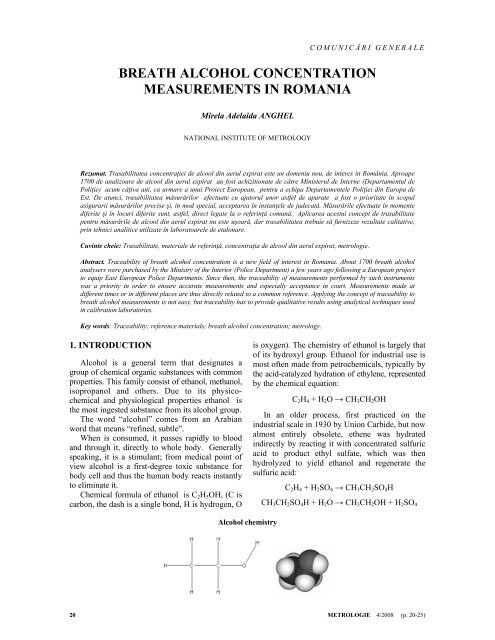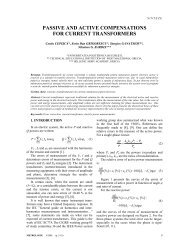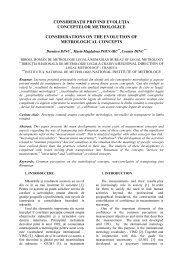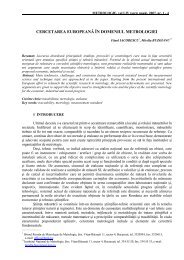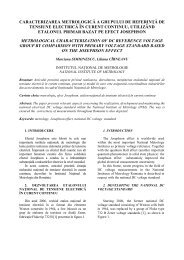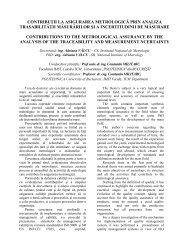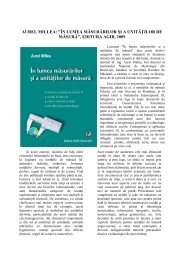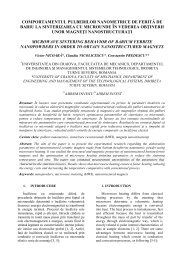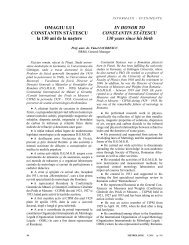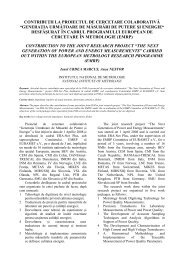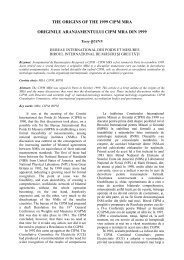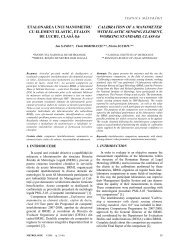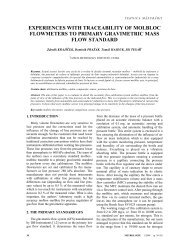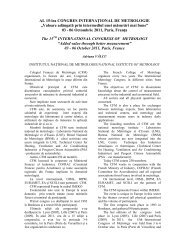breath alcohol concentration measurements in romania
breath alcohol concentration measurements in romania
breath alcohol concentration measurements in romania
You also want an ePaper? Increase the reach of your titles
YUMPU automatically turns print PDFs into web optimized ePapers that Google loves.
COMUNICĂ RI GENERALE<br />
BREATH ALCOHOL CONCENTRATION<br />
MEASUREMENTS IN ROMANIA<br />
Mirela Adelaida ANGHEL<br />
NATIONAL INSTITUTE OF METROLOGY<br />
Rezumat. Trasabilitatea concentraţiei de alcool d<strong>in</strong> aerul expirat este un domeniu nou, de <strong>in</strong>teres în România. Aproape<br />
1700 de analizoare de alcool d<strong>in</strong> aerul expirat au fost achizitionate de cǎtre M<strong>in</strong>isterul de Interne (Departamentul de<br />
Poliţie) acum câţiva ani, ca urmare a unui Proiect European, pentru a echipa Departamentele Poliţiei d<strong>in</strong> Europa de<br />
Est. De atunci, trasabilitatea mǎsurǎrilor efectuate cu ajutorul unor astfel de aparate a fost o prioritate în scopul<br />
asigurarii măsurǎrilor precise şi, în mod special, acceptarea în <strong>in</strong>stanţele de judecatǎ. Mǎsurǎrile efectuate în momente<br />
diferite şi în locuri diferite sunt, astfel, direct legate la o refer<strong>in</strong>ţǎ comunǎ. Aplicarea acestui concept de trasabilitate<br />
pentru măsurările de alcool d<strong>in</strong> aerul expirat nu este uşoară, dar trasabilitatea trebuie să furnizeze rezultate calitative,<br />
pr<strong>in</strong> tehnici analitice utilizate în laboratoarele de etalonare.<br />
Cuv<strong>in</strong>te cheie: Trasabilitate, materiale de refer<strong>in</strong>ţă, concentraţia de alcool d<strong>in</strong> aerul expirat, metrologie.<br />
Abstract. Traceability of <strong>breath</strong> <strong>alcohol</strong> <strong>concentration</strong> is a new field of <strong>in</strong>terest <strong>in</strong> Romania. About 1700 <strong>breath</strong> <strong>alcohol</strong><br />
analysers were purchased by the M<strong>in</strong>istry of the Interior (Police Department) a few years ago follow<strong>in</strong>g a European project<br />
to equip East European Police Departments. S<strong>in</strong>ce then, the traceability of <strong>measurements</strong> performed by such <strong>in</strong>struments<br />
was a priority <strong>in</strong> order to ensure accurate <strong>measurements</strong> and especially acceptance <strong>in</strong> court. Measurements made at<br />
different times or <strong>in</strong> different places are thus directly related to a common reference. Apply<strong>in</strong>g the concept of traceability to<br />
<strong>breath</strong> <strong>alcohol</strong> <strong>measurements</strong> is not easy, but traceability has to provide qualitative results us<strong>in</strong>g analytical techniques used<br />
<strong>in</strong> calibration laboratories.<br />
Key words: Traceability; reference materials; <strong>breath</strong> <strong>alcohol</strong> <strong>concentration</strong>; metrology.<br />
1. INTRODUCTION<br />
Alcohol is a general term that designates a<br />
group of chemical organic substances with common<br />
properties. This family consist of ethanol, methanol,<br />
isopropanol and others. Due to its physicochemical<br />
and physiological properties ethanol is<br />
the most <strong>in</strong>gested substance from its <strong>alcohol</strong> group.<br />
The word “<strong>alcohol</strong>” comes from an Arabian<br />
word that means “ref<strong>in</strong>ed, subtle”.<br />
When is consumed, it passes rapidly to blood<br />
and through it, directly to whole body. Generally<br />
speak<strong>in</strong>g, it is a stimulant; from medical po<strong>in</strong>t of<br />
view <strong>alcohol</strong> is a first-degree toxic substance for<br />
body cell and thus the human body reacts <strong>in</strong>stantly<br />
to elim<strong>in</strong>ate it.<br />
Chemical formula of ethanol is C 2 H 5 OH, (C is<br />
carbon, the dash is a s<strong>in</strong>gle bond, H is hydrogen, O<br />
is oxygen). The chemistry of ethanol is largely that<br />
of its hydroxyl group. Ethanol for <strong>in</strong>dustrial use is<br />
most often made from petrochemicals, typically by<br />
the acid-catalyzed hydration of ethylene, represented<br />
by the chemical equation:<br />
C 2 H 4 + H 2 O → CH 3 CH 2 OH<br />
In an older process, first practiced on the<br />
<strong>in</strong>dustrial scale <strong>in</strong> 1930 by Union Carbide, but now<br />
almost entirely obsolete, ethene was hydrated<br />
<strong>in</strong>directly by react<strong>in</strong>g it with concentrated sulfuric<br />
acid to product ethyl sulfate, which was then<br />
hydrolyzed to yield ethanol and regenerate the<br />
sulfuric acid:<br />
C 2 H 4 + H 2 SO 4 → CH 3 CH 2 SO 4 H<br />
CH 3 CH 2 SO 4 H + H 2 O → CH 3 CH 2 OH + H 2 SO 4<br />
Alcohol chemistry<br />
20 METROLOGIE 4/2008 (p. 20-25)
BREATH ALCOHOL CONCENTRATION MEASUREMENTS IN ROMANIA<br />
Ethanol for use <strong>in</strong> <strong>alcohol</strong>ic beverages, and the<br />
vast majority of ethanol for use as fuel, is produced<br />
by fermentation: when certa<strong>in</strong> species of yeast<br />
(most importantly, Saccharomyces cerevisiae)<br />
metabolize sugar <strong>in</strong> the absence of oxygen, they<br />
produce ethanol and carbon dioxide. The overall<br />
chemical reaction conducted by the yeast may be<br />
represented by the chemical equation:<br />
C 6 H 12 O 6 → 2 CH 3 CH 2 OH + 2 CO 2<br />
2. ALCOHOL AND HUMAN BODY<br />
own capabilities, los<strong>in</strong>g the control on his own<br />
personality.<br />
The subject overreacts. Imm<strong>in</strong>ent dangers are<br />
recognized too late and the reactions are not fitt<strong>in</strong>g<br />
the situations<br />
When somebody dr<strong>in</strong>ks <strong>alcohol</strong>ic beverages, the<br />
<strong>alcohol</strong> passes <strong>in</strong>to the stomach and small <strong>in</strong>test<strong>in</strong>e.<br />
The <strong>alcohol</strong> then diffuses through the stomach/<br />
small <strong>in</strong>test<strong>in</strong>e wall, pass<strong>in</strong>g via the capillaries <strong>in</strong>to<br />
the bloodstream. Most of the <strong>alcohol</strong> is absorbed<br />
via the small <strong>in</strong>test<strong>in</strong>e.<br />
The <strong>alcohol</strong> cont<strong>in</strong>ues to diffuse <strong>in</strong>to the blood<br />
until a stable state is reached.<br />
Scientist from all over the world are study<strong>in</strong>g<br />
new methods and technique to measure the <strong>alcohol</strong><br />
<strong>concentration</strong> from human body, and <strong>in</strong>ternational<br />
organisations issued standards which stands<br />
technological limits for newest devices.<br />
Due to ethanol property of be<strong>in</strong>g volatile a<br />
certa<strong>in</strong> quantity of <strong>alcohol</strong>, proportional with blood<br />
<strong>alcohol</strong> <strong>concentration</strong>, transfers from blood to lung<br />
alveoli, <strong>in</strong> the same way that CO 2 goes from blood<br />
to the lung alveoli <strong>in</strong> order to be elim<strong>in</strong>ated from<br />
human body.<br />
Based on this phenomenon, it is possible to<br />
measure the <strong>alcohol</strong> <strong>concentration</strong> from deep <strong>breath</strong><br />
sample with high accuracy.<br />
An <strong>alcohol</strong> <strong>concentration</strong> of 0,3 ‰ has a<br />
negative <strong>in</strong>fluence on reaction ability: week focus<br />
capacity; impaired cognition; predisposition for<br />
accidents <strong>in</strong>creases; visual angle is narrow<strong>in</strong>g –<br />
“tunnel effect vision”, object seems to be farther<br />
then they are <strong>in</strong> reality.<br />
Start<strong>in</strong>g with 0,5 ‰ reflexes slow down; visual<br />
sensibility decrease and is difficult to appreciate<br />
the speed.<br />
Coord<strong>in</strong>ation of movements is reduced; confusion<br />
<strong>in</strong>creases and orientation is weaker; night vision is<br />
reduced very much. Increas<strong>in</strong>g self-confident<br />
leads to excessive and dangerous ideas about the<br />
The <strong>alcohol</strong> is transported to the liver through<br />
the ve<strong>in</strong>s, where part of the <strong>alcohol</strong> that flows<br />
through the liver is cont<strong>in</strong>uously broken down,<br />
i.e. converted <strong>in</strong>to CO 2 and water and releas<strong>in</strong>g<br />
energy.<br />
The part of the <strong>alcohol</strong>, which is not broken<br />
down, passes via the bloodstream (arteries) to all<br />
parts of the body (<strong>in</strong>clud<strong>in</strong>g the bra<strong>in</strong>) and is<br />
deposited <strong>in</strong> all "aqueous" tissues of the body. Part<br />
of the <strong>alcohol</strong> also flows back to the heart via the<br />
ve<strong>in</strong>s.<br />
Alcohol <strong>in</strong> the bloodstream diffuses <strong>in</strong>to the<br />
body's tissue <strong>in</strong> proportion to the latter's water<br />
content.<br />
Because the water content varies from tissue to<br />
tissue, some tissues absorb more of the <strong>alcohol</strong><br />
than others do; muscles consist of around 80 %<br />
water; fat conta<strong>in</strong>s approximate 20 % water.<br />
This distribution process cont<strong>in</strong>ues until an<br />
equilibrium is reached between the <strong>alcohol</strong> <strong>concentration</strong><br />
<strong>in</strong> the blood and the <strong>alcohol</strong> <strong>concentration</strong><br />
<strong>in</strong> the tissue.<br />
In this stable state, no relative exchanges <strong>in</strong><br />
<strong>alcohol</strong> <strong>concentration</strong> take place.<br />
The <strong>alcohol</strong> <strong>concentration</strong> <strong>in</strong> the blood falls as<br />
<strong>alcohol</strong> <strong>in</strong> the liver is expelled from the body.<br />
METROLOGIE 4/2008 21
Mirela Adelaida ANGHEL<br />
As the <strong>alcohol</strong> <strong>concentration</strong> <strong>in</strong> the bloodstream<br />
falls, <strong>alcohol</strong> diffuses back from the tissue <strong>in</strong>to the<br />
blood.<br />
This process cont<strong>in</strong>ues until all the <strong>alcohol</strong> has<br />
been removed from the body.<br />
The speed at which <strong>alcohol</strong> is broken down<br />
varies from one person to another and generally<br />
cannot be accelerated by dr<strong>in</strong>k<strong>in</strong>g coffee, tak<strong>in</strong>g a<br />
shower etc. In <strong>alcohol</strong>ics, the breakdown of <strong>alcohol</strong><br />
may take place more quickly due to the fact that<br />
the enzymes <strong>in</strong> their liver are more active.<br />
The <strong>concentration</strong> of <strong>alcohol</strong> <strong>in</strong> the blood is<br />
determ<strong>in</strong>ed by the processes of absorption, distribution<br />
and breakdown. The <strong>in</strong>crease <strong>in</strong> blood<br />
<strong>alcohol</strong> <strong>concentration</strong> over time, after consumption<br />
of <strong>alcohol</strong>, depends on various factors:<br />
• duration and quantity of <strong>alcohol</strong> consumption;<br />
• amount of food <strong>in</strong> the stomach;<br />
• weight of the person;<br />
• sex of the person.<br />
Determ<strong>in</strong>ation of <strong>alcohol</strong> <strong>concentration</strong> from<br />
end expiratory sample is based on the pr<strong>in</strong>ciple<br />
accord<strong>in</strong>g to, at equilibrium, <strong>in</strong> a closed system,<br />
the <strong>concentration</strong> of a substance <strong>in</strong> gaseous phase<br />
is proportional with its <strong>concentration</strong> <strong>in</strong> liquid<br />
phase. This pr<strong>in</strong>ciple is known as Henry’s law.<br />
When an aqueous mixture (blood) of a volatile<br />
substance (<strong>alcohol</strong>) reaches equilibrium with air<br />
(<strong>in</strong> the lung), there will be a fixed ratio between<br />
the <strong>concentration</strong> of the substance <strong>in</strong> the air and its<br />
<strong>concentration</strong> <strong>in</strong> the solution.<br />
This ratio (2100:1) rema<strong>in</strong>s constant for a given<br />
temperature (body temperature is constant and<br />
does not depend on the ambient pressure.<br />
Currently, the <strong>breath</strong> <strong>alcohol</strong> value, 2100:1<br />
(<strong>concentration</strong> of <strong>alcohol</strong> <strong>in</strong> the blood to the<br />
<strong>concentration</strong> of <strong>alcohol</strong> <strong>in</strong> the <strong>breath</strong>) is used by<br />
the producers of <strong>breath</strong> <strong>alcohol</strong> analysers and also<br />
by the legislative system as a fixed partition value.<br />
3. METHODS FOR ANALYSIS OF<br />
ALCOHOL IN HUMAN BODY<br />
Qualitative and quantitative methods for analysis<br />
of <strong>alcohol</strong> from biological samples are based on<br />
five analytical pr<strong>in</strong>ciples:<br />
– chemical oxidation;<br />
– enzymatic oxidation;<br />
– gas chromatography;<br />
– electrochemical oxidation;<br />
– Infra Red spectrometry;<br />
– magnetic resonance of 1H-MRS<br />
3.1. Chemical oxidation method<br />
(chemical reactions method;<br />
wet chemistry method)<br />
Erik M.P. Widmark developed the microdiffusion<br />
method for quantitative analysis of blood<br />
<strong>alcohol</strong>. The method consists of direct sampl<strong>in</strong>g of<br />
100 mg of blood <strong>in</strong> S shape glass capillaries, from<br />
f<strong>in</strong>ger or from ear. The <strong>in</strong>ner surface of capillaries<br />
is coated with a thick layer of potassium fluoride<br />
or oxalic potassium to prevent blood coagulation.<br />
Ethanol is oxidized to acetic acid with a mixture of<br />
dichromate and sulphuric acid <strong>in</strong> excess; the<br />
unoxidised quantity is determ<strong>in</strong>ed by iodomentric<br />
titration with natrium tiosulfate.<br />
The method was used <strong>in</strong> Scand<strong>in</strong>avia start<strong>in</strong>g<br />
with 1930-1940 <strong>in</strong> forensic purposes and improved<br />
with different reagents.<br />
3.2. Enzymatic oxidation method<br />
(<strong>alcohol</strong> dehydrogenation)<br />
The enzymatic method used for <strong>alcohol</strong> detection<br />
from biological samples consist of direct analysis<br />
of the sample, diluted (100…1.000) times with a<br />
buffer solution (pH 9,6) before add<strong>in</strong>g necessary<br />
quantities of enzyme and coenzyme (NAD + –<br />
nicot<strong>in</strong>e amide ademyn d<strong>in</strong>ucleotida). Dur<strong>in</strong>g reaction,<br />
NAD + reduces to NADH and the resulted<br />
quantity is proportional with the ethanol <strong>concentration</strong>.<br />
Complete oxidation of ethanol takes about 60<br />
m<strong>in</strong>utes at room temperature and the reduced<br />
coenzyme (NADH) is monitorised by a spectrophotometer<br />
at 340 nm wavelenght. The method<br />
improved dur<strong>in</strong>g the time by automatisation.<br />
3.3. Gas-chromatograph method<br />
This method depends on physico-chemical<br />
properties of ethanol: chemical structure, volatility,<br />
boil<strong>in</strong>g po<strong>in</strong>t and solubility <strong>in</strong> lipid / water. The<br />
method consist of partition of a volatile substance<br />
(ethanol) between an <strong>in</strong>ert mobile phase (carrier<br />
gas – N 2 or He) and a stationary liquid phase,<br />
which is deposit as a layer on an absorbent<br />
material used as support for liquid phase. The<br />
glass or metal column, 2 meters long and <strong>in</strong>terior<br />
diameter of 3 milimeters is filled with a granular<br />
22<br />
METROLOGIE 4/2008
BREATH ALCOHOL CONCENTRATION MEASUREMENTS IN ROMANIA<br />
material. The carrier gas (N 2 ) flows constantly<br />
through the column and at a certa<strong>in</strong> pressure which<br />
allows volatile substance to <strong>in</strong>teract or to establish<br />
equilibrium with stationary liquid phase, conduct<strong>in</strong>g<br />
thus to separation of molecules. After separation,<br />
the ethanol is measured quantitative and qualitative<br />
by a thermoconductometric TCD (Thermo Conductometric<br />
Detector) or by more performant<br />
detector FID (Flame Ionization Detector).<br />
The Chromatographic HeadSpace consists of<br />
dilution of the sample (1:5 or 1:10) with an <strong>in</strong>ternal<br />
standard, <strong>in</strong> a vial ma<strong>in</strong>ta<strong>in</strong>ed at 50 o C. After the<br />
equilibrium is reached vapours are automatically<br />
<strong>in</strong>jected <strong>in</strong>to the column by a syr<strong>in</strong>ge. For<br />
separation can be used either filled or capillary<br />
columns.<br />
3.4. Electrochemical Oxidation Method<br />
(Electrochemical Sensors)<br />
This new analytical pr<strong>in</strong>ciple was developed<br />
at early 1970’s as result of cooperation between<br />
laboratories from Cardiff University and Medical<br />
Centre for Research – London.<br />
The pr<strong>in</strong>ciple consists of electrochemical oxidation<br />
on a catalyst surface and is a detector<br />
(electrochemical fuel cell) for ethanol oxidation.<br />
In order to perform measurement a sample<br />
conta<strong>in</strong><strong>in</strong>g 1.5 L of exhaled air is processed and<br />
displayed <strong>in</strong> approximate 15 seconds. A certa<strong>in</strong><br />
quantity of air <strong>in</strong>tended to be measured, access the<br />
entrance of the sensor us<strong>in</strong>g a sampl<strong>in</strong>g system.<br />
The sensor consists of the follow<strong>in</strong>g ma<strong>in</strong> parts<br />
(see the picture): electrolyte, work<strong>in</strong>g electrode<br />
(cathode) and a count<strong>in</strong>g electrode (anode), as<br />
shown <strong>in</strong> figure 1.<br />
Fig. 1. Electrochemical sensor.<br />
The electrolyte and the material which electrodes<br />
are made from are selected <strong>in</strong> such a way as the<br />
<strong>alcohol</strong> <strong>in</strong>tended to be measured is electrochemically<br />
converted at the cathode, generat<strong>in</strong>g<br />
thus a current that flows through the sensor:<br />
C 2 H 5 OH + 3 H 2 O → 2 CO 2 + 12 H + + 12 e –<br />
Inside the sensor, at the anode, will take place a<br />
chemical reaction with the oxygen from the air:<br />
3 O 2 + 12 H + + 12 e - → 6 H 2 O<br />
Electrochemical sensors have, besides very good<br />
selectivity, the follow<strong>in</strong>g advantages:<br />
‣ high sensitivity at very low <strong>concentration</strong><br />
levels, on the 0,1 ppm ranges (parts per million);<br />
‣ long lifetime (aproximative 5 years);<br />
‣ high accuracy compared with simple and<br />
robust design;<br />
‣ low energy consumption, <strong>in</strong>tegrat<strong>in</strong>g thus the<br />
sensors <strong>in</strong> portable devices.<br />
Electrochemical sensors are not yet prepared to<br />
perform direct measurement, due to the fact that<br />
the current produced at its contacts is proportional<br />
with the total number of the molecules electrochemically<br />
converted <strong>in</strong>to the sensor. In order to be<br />
able to determ<strong>in</strong>e the <strong>concentration</strong> from quantitative<br />
po<strong>in</strong>t of view is necessary to supply a def<strong>in</strong>ite<br />
gas quantity. The problem was solved us<strong>in</strong>g a<br />
sampl<strong>in</strong>g system.<br />
3.5. Infra Red spectrometry method<br />
(<strong>in</strong>frared radiation absorption)<br />
Infrared spectrometry is an non-destructive<br />
analytical method promoted at early 1960’s.<br />
The method is based on absorption of <strong>in</strong>frared<br />
radiations and on Beer-Lambert law for qualitative<br />
and quantitative analysis of <strong>alcohol</strong> samples taken<br />
from human body.<br />
Beer-Lambert law states the relationship between<br />
<strong>concentration</strong> and <strong>in</strong>frared absorption and is<br />
expressed by the formula:<br />
−KC<br />
I = I 0 e<br />
(1)<br />
where: I is the <strong>in</strong>tensity of electromagnetically<br />
radiation at detector;<br />
I 0 – <strong>in</strong>tensity of electromagnetically radiation<br />
generated by <strong>in</strong>frared source;<br />
K – analyser’s specific constant; depends on<br />
wavelength and measur<strong>in</strong>g chamber<br />
length;<br />
C – <strong>breath</strong> <strong>alcohol</strong> <strong>concentration</strong>.<br />
An <strong>in</strong>frared detector, presented <strong>in</strong> figure 2,<br />
consists of:<br />
1 – <strong>in</strong>frared source;<br />
2 – measur<strong>in</strong>g chamber;<br />
3 – lens;<br />
4 – chopper with filters for narrow wavelength<br />
range;<br />
5 – high sensivity photodetector;<br />
6 – microprocessor.<br />
METROLOGIE 4/2008 23
Mirela Adelaida ANGHEL<br />
Fig. 2. Infrared detector.<br />
3.6. Magnetic resonance of 1H-MRS<br />
The method studies physical <strong>in</strong>teraction of <strong>alcohol</strong><br />
with bra<strong>in</strong> tunic. This conta<strong>in</strong>s proteic elements,<br />
called “receptors” which communicate neuronal<br />
activity, allow<strong>in</strong>g us to move, to feel, to th<strong>in</strong>k<br />
and to remember. In order to function properly, the<br />
receptors must be positioned correctly <strong>in</strong> membrane.<br />
Alcohol adheres to membrane, brak<strong>in</strong>g off the<br />
normal position of receptors, which modify the<br />
normal function of the bra<strong>in</strong> and lead to <strong>in</strong>toxication,<br />
tolerance, addiction, and <strong>alcohol</strong> problems. This<br />
adhesion phenomenon <strong>in</strong> known as “magnetisation<br />
transfer” effect. Alcohol exists <strong>in</strong> tissues <strong>in</strong> different<br />
molecular environments; is exist <strong>in</strong> <strong>in</strong>tra- and extracellular<br />
fluids, case <strong>in</strong> which is named “free”<br />
<strong>alcohol</strong> and exists molecular state, <strong>in</strong>teract<strong>in</strong>g or<br />
adher<strong>in</strong>g to the cell’s membrane, case <strong>in</strong> which is<br />
named “bonded” <strong>alcohol</strong>. 1 H MRS technology<br />
(Proton’s Magnetic Resonance) allows direct measurement<br />
only of “free” <strong>alcohol</strong> not of “bonded”<br />
<strong>alcohol</strong>. That means “bonded” <strong>alcohol</strong> is <strong>in</strong>visible<br />
for “1 H MRS” method. Although is not detectable<br />
by this method “bonded” <strong>alcohol</strong> is responsible for<br />
the effects on bra<strong>in</strong>’s functions.<br />
Bra<strong>in</strong> <strong>alcohol</strong> <strong>concentration</strong> is a sum of “free”<br />
and “bonded” <strong>alcohol</strong>. If the detected bra<strong>in</strong> <strong>alcohol</strong><br />
<strong>concentration</strong> is 90 % of the value measured from<br />
blood and <strong>breath</strong> means that 10 % of <strong>alcohol</strong> is<br />
“bonded”. If the measured value is 50 % then<br />
50% of <strong>alcohol</strong> is “bonded”. This difference is<br />
very big, especially if is considered the fact that<br />
“bonded” <strong>alcohol</strong> is the most likely responsible of<br />
the effect of <strong>alcohol</strong> aga<strong>in</strong>st bra<strong>in</strong>’s function; this is<br />
the reason of how important is to know exactly the<br />
properties of <strong>alcohol</strong>. Alcohol has different effects<br />
on different parts of the bra<strong>in</strong>.<br />
4. AIR: BLOOD PARTITION RATIO AND<br />
CONVERSION OF BLOOD ALCOHOL<br />
CONCENTRATIO – BAC IN BREATH<br />
ALCOHOL CONCENTRATION – BRAC<br />
4.1. Air : blood partition ratio<br />
It is known that partition ratio of ethanol<br />
between its <strong>concentration</strong> <strong>in</strong> blood and to the<br />
<strong>concentration</strong> <strong>in</strong> the exhale air is governed by<br />
Henry’s law.<br />
Accord<strong>in</strong>g to this law when a volatile chemical<br />
substance (ethanol) is dissolved <strong>in</strong> a liquid (blood),<br />
<strong>in</strong> a sealed recipient, <strong>in</strong> which is present air<br />
(alveolar air) equilibrium is established between<br />
the <strong>concentration</strong> of the volatile substance <strong>in</strong> air<br />
and its <strong>concentration</strong> <strong>in</strong> the aqueous mixture. This<br />
law is valid for well-def<strong>in</strong>ed values for pressure<br />
and temperature.<br />
This law states that, at equilibrium, measur<strong>in</strong>g<br />
ethanol <strong>concentration</strong> <strong>in</strong> gaseous phase is possible<br />
to determ<strong>in</strong>e its <strong>concentration</strong> <strong>in</strong> liquid phase.<br />
The follow<strong>in</strong>g comparison can be used: recipient<br />
represents lungs, blood from lungs is like aqueous<br />
solution and <strong>breath</strong> is represented by gaseous<br />
phase above the liquid.<br />
Unfortunately, Henry’s law applies to the lung<br />
if the follow<strong>in</strong>g three conditions are fulfilled:<br />
‣ solution must be <strong>in</strong> a sealed recipient. Lungs<br />
are a dynamic system rather then a closed one;<br />
‣ solution must be ma<strong>in</strong>ta<strong>in</strong>ed at a known constant<br />
value. Lung’s temperature is never accurately<br />
known and is chang<strong>in</strong>g constantly;<br />
‣ pressure must be ma<strong>in</strong>ta<strong>in</strong>ed at a constant<br />
value. The pressure <strong>in</strong>side the lungs is chang<strong>in</strong>g<br />
constantly, hav<strong>in</strong>g lower values to allow <strong>in</strong>hal<strong>in</strong>g<br />
and higher values to allow exhal<strong>in</strong>g.<br />
Recent research demonstrated that ethanol is not<br />
diffus<strong>in</strong>g <strong>in</strong> alveolar space as it was believed.<br />
In fact, diffusion occurs <strong>in</strong> aerial capillary of<br />
the lungs avoid<strong>in</strong>g alveoli. Conclusion is that there<br />
is not a stable partition ratio for human body and<br />
cannot be predicted for sure any partition ratio for<br />
a certa<strong>in</strong> person. In this case, 2100 :1 ratio will be<br />
<strong>in</strong>correct <strong>in</strong> the most part of time.<br />
Another problem is generated by the fact that<br />
dur<strong>in</strong>g absorption (when ethanol is absorbed <strong>in</strong><br />
blood stream of small <strong>in</strong>test<strong>in</strong>e) the value of<br />
partition ratio drops to a smaller value when the<br />
abortion is completed.<br />
Therefore, for each person, the partition ratio<br />
will change the value while the ethanol is absorbed<br />
and elim<strong>in</strong>ated.<br />
In addition, the hematocrit and water <strong>concentration</strong><br />
from human body‘s blood is variable, chang<strong>in</strong>g<br />
partition ratio, lead<strong>in</strong>g to additional uncerta<strong>in</strong>ties.<br />
24<br />
METROLOGIE 4/2008
BREATH ALCOHOL CONCENTRATION MEASUREMENTS IN ROMANIA<br />
REFERENCE<br />
STANDARDS<br />
Calibrated Ethylometer<br />
ALCOTEST 7110 MK III<br />
U = 0.003 mg/dm 3<br />
(with k=2)<br />
Direct calibration<br />
methods<br />
SECONDARY<br />
STANDARDS<br />
TESTING /<br />
CALIBRATION SYSTEM<br />
U = 0.005 mg/dm 3<br />
(with k=2)<br />
Fig. 3. Traceability cha<strong>in</strong> for mass<br />
<strong>concentration</strong> of <strong>alcohol</strong> <strong>in</strong> exhaled <strong>breath</strong><br />
measurement results.<br />
Direct measurement<br />
methods<br />
WORKING<br />
INSTRUMENTS<br />
ETHYLOTEST<br />
U = 0.017 mg/dm 3<br />
(with k=2)<br />
4.2. CONVERSION OF BLOOD ALCOHOL<br />
CONCENTRATION – BAC IN BREATH<br />
ALCOHOL CONCENTRATION – BRAC<br />
Blood <strong>alcohol</strong> <strong>concentration</strong> of a subject, which<br />
dr<strong>in</strong>ks <strong>alcohol</strong>, can be calculated us<strong>in</strong>g the equation:<br />
Consumed<strong>alcohol</strong>quantity<br />
( )<br />
( g)<br />
BAC mg/100 mL =<br />
× 100<br />
Body weight ( kg)<br />
× Widmark factor<br />
(2)<br />
where: one millilitre of <strong>alcohol</strong> weights 0,79 grams;<br />
partition ratio between the <strong>concentration</strong> of the<br />
substance <strong>in</strong> the solution (blood) and its <strong>concentration</strong><br />
<strong>in</strong> air (BAC:BrAC) is 2100:1.<br />
Note that a traceability cha<strong>in</strong> <strong>in</strong> this field is<br />
presented <strong>in</strong> figure 3.<br />
5. CONCLUSIONS<br />
Breath <strong>alcohol</strong> analysers are widely accepted as<br />
legal measur<strong>in</strong>g devices used for determ<strong>in</strong>ation of<br />
mass <strong>concentration</strong> of <strong>alcohol</strong> from deep lung<br />
<strong>breath</strong> sample. Nowadays, Police Department from<br />
M<strong>in</strong>istry of Interior is us<strong>in</strong>g about 1700 electronic<br />
devices to measure <strong>breath</strong> <strong>alcohol</strong> <strong>concentration</strong>s.<br />
Gas Concentration Department has started a<br />
project to prepare ethanol <strong>in</strong> air standard mixtures<br />
<strong>in</strong> order to assure the follow<strong>in</strong>g control procedures:<br />
• <strong>in</strong>itial tests of new <strong>breath</strong> <strong>alcohol</strong> analysers;<br />
• periodic verification;<br />
• performance tests and calibrations.<br />
Dur<strong>in</strong>g two years of susta<strong>in</strong>ed research activity<br />
there were prepared different <strong>concentration</strong>s of<br />
<strong>alcohol</strong>; their associated uncerta<strong>in</strong>ties have been<br />
evaluated accord<strong>in</strong>g to the latest standards [1,2].<br />
The results obta<strong>in</strong>ed show that the National<br />
Institute of Metrology’s standards, prepared accord<strong>in</strong>g<br />
to the European and International Standards<br />
and with the knowledge and equipment <strong>in</strong><br />
existence <strong>in</strong> the INM laboratory, are of the<br />
required accuracy and can be used to transmit the<br />
measur<strong>in</strong>g unit, mg/L, to <strong>breath</strong> <strong>alcohol</strong> analysers.<br />
References<br />
[1] Guide to the expression of uncerta<strong>in</strong>ty <strong>in</strong> measurement<br />
(GUM), first edition, 1995, ISO, BIPM, IEC, IFCC,<br />
IUPAC, IUPAP, OIML (published by ISO)<br />
[2] Eurachem/CITAC Guide, “Quantify<strong>in</strong>g Uncerta<strong>in</strong>ty <strong>in</strong><br />
Analytical Measurement”, 2nd edition 2000, Published by<br />
LGC, UK<br />
[3] International Vocabulary of Basic and General Terms <strong>in</strong><br />
Metrology (VIM), BIPM, IEC, IFCC, ISO, IUPAC, OIML.<br />
Published by ISO, Geneva, Switzerland, 2nd ed., 1993<br />
[4] OIML R 126: “Evidential <strong>breath</strong> analysers”, OIML, 1998<br />
[5] DIN VDE 0405, “Determ<strong>in</strong>ation of Breath Alcohol<br />
Concentration”, 1995<br />
[6] A.Slemeyer, “A Depletion Compensated Wet Bath<br />
Simulator For Calibrat<strong>in</strong>g Evidential Breath Alcohol<br />
Analyzers”, University of Applied Science of Giessen<br />
[7] A.Slemeyer, “Calibrat<strong>in</strong>g Gas Generator”, University of<br />
Applied Science of Giessen, 1998<br />
[8] Johannes Lagois, Jürgen Sohège, “Breath Alcohol test<strong>in</strong>g<br />
Dräger Alcotest 7410 Plus RS”, Dräger Review, 2003<br />
Scientific revue:<br />
Dragoş BOICIUC: doctor, scientific researcher 1 st<br />
degree, Director National Institute of Metrology, e-<br />
mail: dragos.boiciuc@<strong>in</strong>m.ro<br />
About the autor:<br />
Mirela Adelaida ANGHEL: scientific researcher 3 rd<br />
degree III at the National Institute of Metrology, e-<br />
mail: mirela.anghel@<strong>in</strong>m.ro<br />
METROLOGIE 4/2008 25


